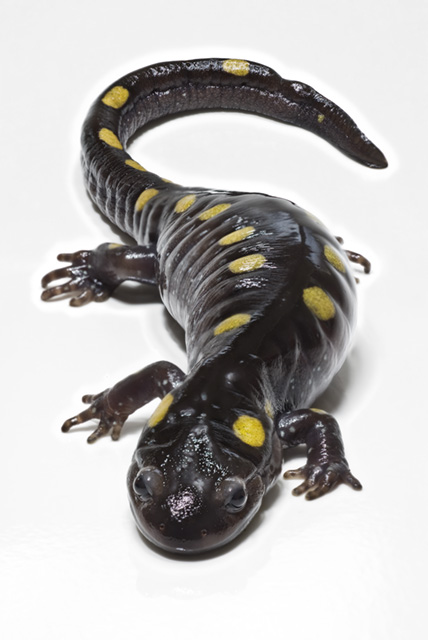Science News
Salamanders and Algae

It has long been known that the spotted salamander or Ambystoma maculatum has a symbiotic relationship with algae. New research now shows that their bond goes even deeper.
In 1888, scientists discovered that a type of algae grows inside the eggs of spotted salamanders as the embryos develop. Biologist Renn Tumilson describes the process this way on the Henderson State University website:
The alga, called Oophila amblystomatis (which means “loves salamander eggs”) can invade the membranes of the eggs and grow there. The alga photosynthesizes and produces oxygen near the embryo where it is needed. In exchange, the carbon dioxide released by metabolism from the embryo is just what is needed by the alga.
Scientists studying the symbiotic relationship believed the algae only existed inside the eggs. But last week, scientists speaking at the Ninth International Congress of Vertebrate Morphology in Punta del Este, Uruguay presented new findings that show that the algae are actually inside cells covering the salamanders’ bodies. As reported online by Nature, the symbiosis continues:
Moreover, there are signs that intracellular algae may be directly providing the products of photosynthesis — oxygen and carbohydrate — to the salamander cells that encapsulate them.
One of the researchers, Ryan Kerney of Dalhousie University, was staring at the eggs when he noticed the algae green “comes from within the embryos themselves, as well as from the jelly capsule that encases them.”
Where that algae come from still baffles the researchers. One possibility is that the algae are passed down from the mother. Nature gives another possibility, too:
Because salamanders can re-grow limbs, almost all the cells in a grown adult retain a degree of pluripotency — that is, the specialized cells can continue to divide and change into other cell types throughout the salamander's life.
It may be that specialized cells in these adult salamanders are able to accommodate algae inside them because the process by which they learn self-recognition is different from that of other vertebrates.
Algae have been found in similar symbiotic relationships with invertebrates like corals, but this is currently the only example with vertebrates. Scientists wonder if there could be more salamanders that hold algae so dear. According to Nature, Congress attendee Daniel Buchholz, a developmental biologist at the University of Cincinnati in Ohio, said, “I think that if people start looking we may see many more examples.”
Creative Commons image by Scott Camazine